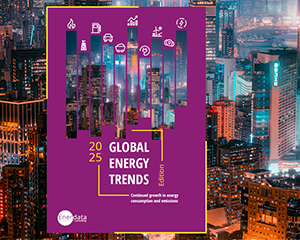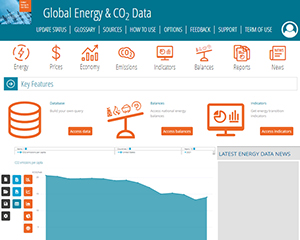用語集
LNGの貿易収支
The trade balance is the difference between imports and exports. The balance of a net exporter appears as a negative value (-). The balance of geographic and geopolitical zones is simply the sum of the trade balance of all the countries. LNG (liquefied natural gas) is natural gas, mainly made of methane (CH4), that is cooled down at -160°C to become liquid and non-corrosive, and to reduce its volume by around 600 times. LNG can thus be stored in tanks and can be easily transported by ship instead of gas pipelines, increasing the flexibility of global gas trade.
世界精製された製品の生産
Petroleum products are all liquid hydrocarbons, obtained by the refining of crude oil and NGL and by treatment of natural gas; in particular, LPG production (Liquid Petroleum Gas) includes LPG from natural gas separation plants. The alcohol used as motor fuel in Brazil as well as fuels derived from coal in South Africa are not included in oil products.
原油の貿易収支
The trade balance is the difference between imports and exports. The balance of a net exporter appears as a negative value (-). The balance of geographic and geopolitical zones is simply the sum of the trade balance of all the countries. Crude oil includes all liquid hydrocarbons to be refined: crude oil, liquids from natural gas (Natural Gas Liquid or NGL) and semi-refined products.
原油生産統計
Crude oil production corresponds to gross production. Crude oil includes all liquid hydrocarbons to be refined: crude oil, liquids from natural gas (Natural Gas Liquid or NGL) and semi-refined products.
国内の天然ガス消費量
Consumption (or domestic supply) is the balance of production, external trade and stock changes. Natural gas is mainly made of methane (CH4). It is marketed after separation of the liquid fractions. The calorific power of natural gas varies according to its methane concentration. The standard coefficient used by Enerdata is: 0.82 toe/m3, for important countries national coefficients are used.
国内の石炭と亜炭消費量
Consumption (or domestic supply) is the balance of production, external trade and stock changes. Coal and lignite represent all mineral solid fuels. Their calorific values vary very much from hard coal to lignite (national average coefficients are used).
国内の電力消費量
Consumption (or domestic supply) is the balance of production and external trade. It is mainly divided between power plants, industry, transport and the residential and tertiary sectors, one part is used or lost in the energy transformation. Electricity corresponds to the electricity produced and transported for commercial purposes, used by ad-hoc devices.
国内オイル製品の消費量
Consumption (or domestic supply) is the balance of production, external trade and stock changes. Marine bunkers are excluded for countries. They are included at the world level. Consumption is mainly divided between power plants, industry, transport and the residential and tertiary sectors, one part is used or lost in the energy transformation. Petroleum products are all liquid hydrocarbons, obtained by the refining of crude oil and NGL and by treatment of natural gas; in particular, LPG production (Liquid Petroleum Gas) includes LPG from natural gas separation plants. The alcohol used as motor fuel in Brazil as well as fuels derived from coal in South Africa are not included in oil products.
天然ガスの貿易収支
The trade balance is the difference between imports and exports. The balance of a net exporter appears as a negative value (-). The balance of geographic and geopolitical zones is simply the sum of the trade balance of all the countries. Natural gas is mainly made of methane (CH4). It is marketed after separation of the liquid fractions. The calorific power of natural gas varies according to its methane concentration. The standard coefficient used by Enerdata is: 0.82 toe/m3, for important countries national coefficients are used.
天然ガス生産
Natural gas production corresponds to the marketed production (i.e. excluding quantities flared or reinjected). Natural gas is mainly made of methane (CH4). It is marketed after separation of the liquid fractions. The calorific power of natural gas varies according to its methane concentration. The standard coefficient used by Enerdata is: 0.82 toe/m3, for important countries national coefficients are used.
定数PPPでのCO2強度
CO2 intensity is the ratio of CO2 emissions from fuel combustion over Gross Domestic Product (GDP). It measures the CO2 emitted to generate one unit of GDP. GDP is expressed at constant exchange rate and purchasing power parity to remove the impact of inflation, reflect differences in general price levels and relate energy consumption to the real level of economic activity. Using purchasing power parity rates for GDP instead of exchange rates increases the value of GDP in regions with a low cost of living, and therefore decreases their CO2 intensities. CO2 emissions cover only the emissions for fossil fuels combustion (coal, oil and gas).
定数PPPでGDPのエネルギー強度
The energy intensity is calculated by dividing the total energy consumption of a country by its Gross Domestic Product (GDP). It measures the total amount of energy necessary to generate one unit of GDP. Total energy consumption includes coal, gas, oil, electricity, heat and biomass. GDP is expressed at constant exchange rate and purchasing power parity to remove the impact of inflation and reflect differences in general price levels and relate energy consumption to the real level of economic activity. Using purchasing power parity rates for GDP instead of exchange rates increases the value of GDP in regions with a low cost of living, and therefore decreases their energy intensities.
平均二酸化炭素排出係数
The average CO2 emission factor (carbon factor) is calculated by the ratio between CO2 emissions to primary energy consumption.
燃料燃焼のCO2排出量データ
CO2 emissions cover only the emissions from fossil fuels combustion (coal, oil and gas) by sector. They are calculated according to the UNFCCC methodology (in line with the 2006 IPCC Guidelines for National Greenhouse Gas Inventories).
石炭と亜炭の貿易収支
The trade balance is the difference between imports and exports. The balance of a net exporter appears as a negative value (-). The balance of geographic and geopolitical zones is simply the sum of the trade balance of all the countries. Coal and lignite represent all mineral solid fuels. Their calorific values vary very much from hard coal to lignite (national average coefficients are used).
石炭と亜炭生産
Coal production corresponds to gross production. Coal and lignite represent all mineral solid fuels. Their calorific values vary very much from hard coal to lignite (national average coefficients are used).
精製された製品の貿易収支
The trade balance is the difference between imports and exports. The balance of a net exporter appears as a negative value (-). The balance of geographic and geopolitical zones is simply the sum of the trade balance of all the countries. Petroleum products are all liquid hydrocarbons, obtained by the refining of crude oil and NGL and by treatment of natural gas; in particular, LPG production (Liquid Petroleum Gas) includes LPG from natural gas separation plants. The alcohol used as motor fuel in Brazil as well as fuels derived from coal in South Africa are not included in oil products.
総エネルギー消費量
For each energy product, it is the sum of primary production, external trade, marine bunkers (fuel used by boats and aircraft for international transport) and stock variations. For the world, marine bunkers are included. This induces a gap with the sum of regions. Total energy includes coal, gas, oil, electricity, heat and biomass.
総エネルギー貿易収支
The trade balance is the difference between imports and exports. The balance of a net exporter appears as a negative value (-). The balance of geographic and geopolitical zones is simply the sum of the trade balance of all the countries. Total energy includes coal, gas, oil, electricity, heat and biomass.
総最終エネルギー消費量における電力の割合
Share of electricity in total final energy consumption.
総第一次エネルギー生産統計
The primary production evaluates the quantity of natural energy resources ("primary energy sources") extracted or produced. It includes coal, gas, oil, electricity, heat and biomass production. For natural gas, the quantities flared or reinjected are excluded. Production of hydro, geothermal, nuclear and wind electricity is considered as primary production.
電力の貿易収支
The trade balance is the difference between imports and exports. The balance of a net exporter appears as a negative value (-). The balance of geographic and geopolitical zones is simply the sum of the trade balance of all the countries. Electricity corresponds to the electricity produced and transported for commercial purposes, used by ad-hoc devices.
電力生産
Electricity production corresponds to gross production. It includes the public production (production of private and public electricity utilities) and the autoproducers, by any type of power plants (including cogeneration). Electricity corresponds to the electricity produced and transported for commercial purposes, used by ad-hoc devices.
電力生産における風力と太陽光の割合
Electricity produced from wind and solar energy divided by the total electricity production.
電力生産内の再生可能の割合(水力発電を含む)
Ratio between the electricity production from renewable energies (hydro, wind, geothermal and solar) and the total electricity production. Electricity corresponds to the electricity produced and transported for commercial purposes, used by ad-hoc devices.
「世界エネルギー動向」(2025年版)は、重要なエネルギーデータに関する洞察を示しています。
当社は、これらの調査結果を長期的な気候目標に照らし合わせて考察しました。
- 2050年目標の達成に向けて、さらなる努力が求められる地域とは?
- 欧州がパリ協定の目標達成に苦戦している根本的な要因とは?
- 気候変動の緩和に大きく寄与している地域とは?
エネルギーの供給、需要、価格、ならびに温室効果ガス排出量(186か国)に関連した、この上なく包括的で最新なデータベースにアクセスしてください。
- 包括的
- 1990年以降の年間エネルギーおよびGHGデータ
- 年間最大2000以上の国別データシリーズと指標
- すべてのエネルギーについて 186カ国のカバレッジ
- エネルギー収支と統計に関する30年の経験



